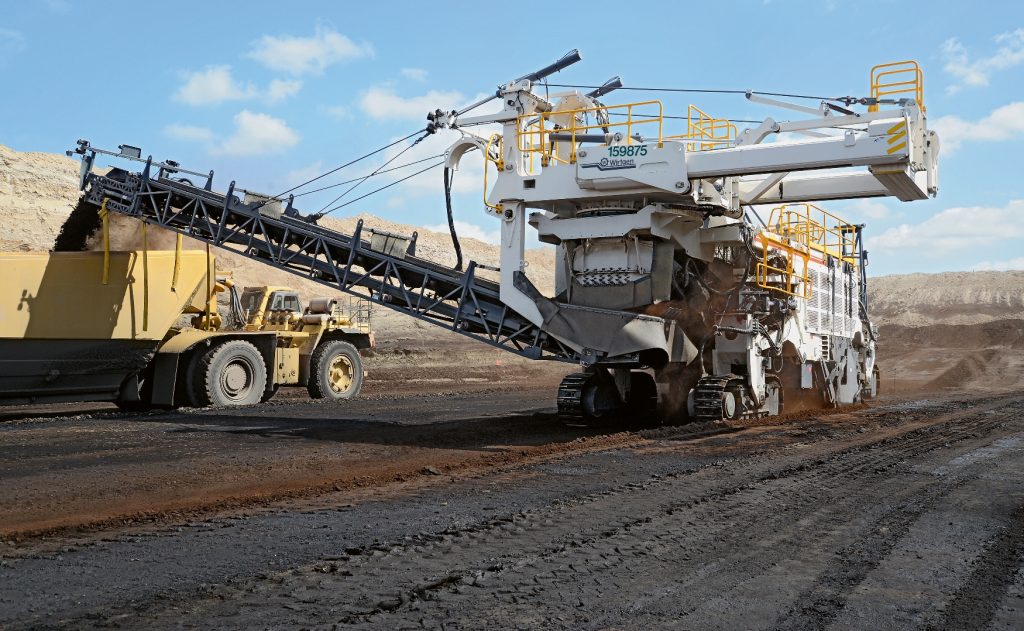Two type 4200 SM Wirtgen surface miners are bringing light to South Texas and Northern Mexico. A 4200 SM is extracting sub-bituminous coal at an open cast mine owned by the North American Coal Corp. in Eagle Pass, Texas, USA – right on the border with Piedras Negas, Coahuila, Mexico. The extracted coal is then transported over the border by train to a multi-unit power plant in Coahuila. Meanwhile, at another open cast mine in Texas, another 4200 SM is extracting lignite, just as economically.
The two surface miners – the largest models in Wirtgen’s product range – went into operation in the last two years and are extracting coal with a low sulphur content, operating 24/7. The 4200 SM is 6.53 m high and has an operating weight of 204,300 kg. It is powered by a highly efficient diesel engine with 1,521 HP. When cutting soft material such as coal, limestone or gypsum, the 4200 SM cuts down to a depth of 830 mm using a 4,200 mm-wide milling drum and operating in an up-cut direction.
Eagle Pass Mine is located in an area which has been worked for coal since as early as the late 19th century. Piedras Negras, the name of the town on the other side of the border, translates as “black stones”, a reference to the coal deposits located there. “Every tonne we extract goes to a coal-fired power plant in Mexico,” says John C. Duffey, P.E., Chief Engineer of Camino Real Fuels. A subsidiary of the North American Coal Corp., this company operates the mine for the owner, Dos Republicas Coal Partnership (DRCP). Eagle Pass has replaced the depleted open-cast mine Siglo XXI (21st century) in Mexico, on the other side of the Rio Grande – or Rio Bravo, as it is known in Mexico.
At the mine, a 2,550 ha area is available for coal extraction, offering sufficient deposits for eight years of mining work. The total quantity of deposits is much larger, however. One special feature of this location is the fact that the seams are very thin, some of them only 15 cm thick. “And this is precisely where the Wirtgen surface miner proves invaluable. We use it to selectively extract coal from the rock. This enables us to achieve a high material quality,” explains Duffey.
The four seams lie beneath an 18.3 m layer of top soil and overburden, in a series of layers around 6.0 m thick. “Barely 1.65 to 2 m of this is coal,” says Duffey. “We conduct preliminary examinations in an attempt to find out exactly how much coal there is under the surface, but we are often surprised.” The 4200 SM transfers a 250 t payload onto dumpers. They transport the coal to a transshipment centre equipped with five grizzlies and conveyors. Each grizzly supplies one loading conveyor which transports the coal to the train-loading station.
“The thin seams can be mined precisely with the Wirtgen 4200 SM, which also saves us a great deal of money for processing,” says Duffey. “We don’t need a primary crusher at the transshipment center anymore, because the 4200 SM crushes the coal directly during loading.” The surface miner crushes the coal to a maximum size of 10 cm while minimising fines. As coal fines tend to block the loading conveyors at the transfer points when there is a high moisture content, a low proportion of fines is a great advantage.
“Blasting, excavating and loosening – the 4200 SM does away with all this,” explains Duffey. “We don’t have a permit for blasting and we don’t blast coal or surrounding rock. Almost 95% of our coal is crushed and loaded by the 4200 SM. The remaining 5% – for instance, material located in inaccessible corners or right at the end of a drift – is broken up by bulldozers and loaded by front loaders.”
At the other open cast mine in Texas, the lignite used to be extracted by two smaller, older surface miners. The Wirtgen 4200 SM was bought in 2014, when these two miners were approaching the end of their service lives. “The 4200 SM is technologically superior in terms of its hydraulics and control system. What is more, it loads dumpers 30 to 40% faster than the older models,” say the drivers. Compared with the mining methods used in the past, the 4200 SM produces fewer fines and more material in the target grain size. The selective mining method extracts material with a high degree of purity, reducing coal washing costs at the processing plant. This also enhances the quality of the end product, enabling the coal to be sold at a more profitable price.











